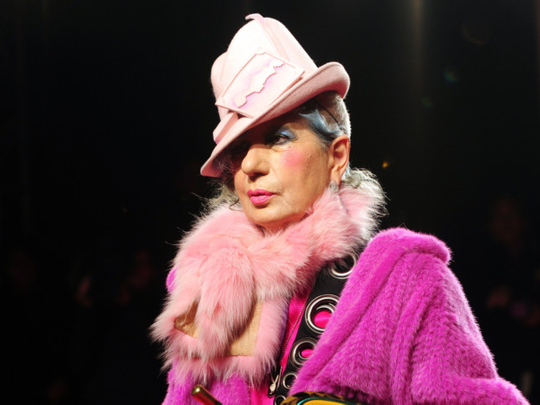
Had the fashion editor Anna Piaggi been British, instead of merely discovering her lifetime style in London, she might have seemed less amazing. Historicism plus eclecticism, electrified with eccentricity, has long been a norm in British fashion. Piaggi improvised impromptu outfits, collages of garments, to tell new stories, as well as letting her clothes narrate their own pasts. “They are all things that have many lives,” she told the writer Tamsin Blanchard in 2004, as they excavated a corner of her wardrobe. “They have already lived.”
Piaggi, who has died aged 81 on Tuesday, told similar fashion stories in magazines, juxtaposing images on the page to make connections between the past and present, reality and fiction. She was fashion editor for Arianna magazine, editor in chief of the short-lived but influential Vanity (1981-83), and wrote for other Italian publications, but the features that really mattered were her doppie pagine (“double pages”) for Italian Vogue, where she was creative consultant from 1988. These were collected as a book, Fashion Algebra, in 1998. Her pinboard or mood-board approach has since become standard in magazines, but few others have reached Piaggi’s level of wit and knowledge.
She was born in Milan. Clothes were not her original interest, although she could remember visiting as a child the city’s La Rinascente department store, where her father was a manager (he died when she was seven). She had a strict education, was good at languages, and was working as a translator at the publishers Mondadori when she met the photographer Alfa Castaldi, whom she married in 1962. He charmed her into his bohemian world, and encouraged her to work in fashion.
Bohemian fashion in the ’60s meant regular trips to London, and there Piaggi met the dandy antique clothing dealer Vernon Lambert in 1967. Wearing vintage had been a posh London style for several years, as had combining it with the latest designs from Biba, plus the new ethnic garments and accessories, to assemble an outfit with a long, deep, backstory. Those who were rich enough bought from dealers such as Lambert in the Chelsea antique market: Lambert bought from stalls, auction houses, secretive and fierce old ladies, and Debenham & Freebody and other outmoded emporia as they closed their cold-store facilities and found rails of unclaimed robes.
Piaggi, with Lambert’s guidance, began collecting — they went to Bermondsey market at dawn, torch in hand, and bought off the pavement. Her purchases included ensembles originally made for the Ballets Russes. She later added superb opera and stage costumes, and wore them as she did everything else, as part of a look, that might also include Land Army breeches bought in the Laurence Corner surplus store and shoes by Manolo Blahnik. “Professional play,” she called it.
Piaggi’s contemporary choices were absolutely of the moment — Ossie Clark, Zandra Rhodes, Kenzo, Missoni — yet enduring. Forty years after it was made, she could turn up in a Karl Lagerfeld for Chloe blouse that had not dated by a day.
For a decade after their first meeting in 1974, Lagerfeld and Piaggi were a unit. Lagerfeld drew her regularly for years to record the day’s combinations, as he appreciated that her metier was dress as performance art: “She’s a great performer, but she is also the author of the play.”
His sketches were published as Karl Lagerfeld: A Fashion Journal: A Visual Record of Anna Piaggi’s Creative Dressing and Self-Editing (1986).
Piaggi claimed never to have worn the same outfit in public twice, but that was because she revisited her wardrobe, adding to and rearranging items to make up fresh stories and keeping Polaroids of what had already been tried. When she travelled, she arrived with several trunks just for a weekend, in order to have sufficient choice. When she covered the fashion collections, she took a van with rails. She became a spectacle, an entertainment, both a commentary on, and a rebuke to, what was on the catwalk — whatever it was, she had one already, and had been wearing it for years. Predicting what came next, through knowing what had come before, was her talent.
Piaggi stated candidly that she had never been photogenic, and, as she aged, she adopted Elizabeth I’s technique, stylising her appearance — white face, cartoon features painted on, blue and silver waves on hair cropped short since 1982 the better to support a small, cockamamie hat, usually by Stephen Jones. She made the International Best Dressed List repeatedly, joining its hall of fame in 2007. A 2006 Victoria & Albert Museum exhibition, Anna Piaggi: Fashion-ology, was an unexpected success, full of fashion students thrilled to discover that Piaggi owned 24 aprons and 31 feather boas, and wore them in the teeth of good taste, possibly with a ski pole in lieu of walking stick.
Castaldi died in 1995. Piaggi moved some of their many possessions to another Milan apartment, naturally one with a walk-in wardrobe, and played on.












